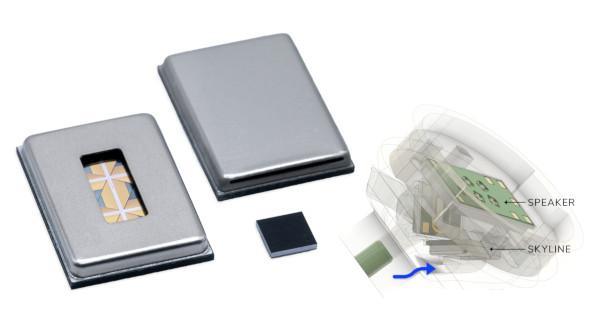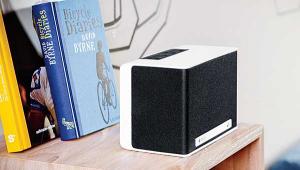Tech Watch: Silicon-Based xMEMS Microspeakers

The Santa Clara, CA-based firm has set its sights on replacing coil-based driver technology that has dominated audio for nearly 100 years with a full-range silicon-based microspeaker it hopes will find its way into the next generation of earbuds. Since opening its doors in 2018, the startup has been quietly perfecting the first-of-its-kind driver, demonstrating its progress along the way without making much of a splash — at least among the general public.
It appears xMEMS fortunes are about to change.
The company, which describes itself as “laser-focused on modernizing century-old microspeaker technology,” has created three MEMS (Micro-Electro-Mechanical Systems) microspeakers, which are protected by more than 90 patents with an additional 100-plus pending. Applications include wired and wireless earbuds, hearing aids, and, in the case of its most recent design, smart glasses, virtual reality headsets, and loudspeaker tweeter arrays.

A long list of advantages are promised for the solid-state microspeakers xMEMS is pitching to earbud manufacturers. Stated benefits start with the ability to produce a driver that’s a mere 1/25th of an inch (1mm) thick — leaving more room for batteries, sensors, and other components — and being able to implement the entire speaker (actuator and membrane) in silicon, eliminating the need for driver matching and calibration. And from a production standpoint, xMEMS technology makes it possible to reliably mass produce hi-res-capable microspeakers that are more precise than traditional designs, including balanced-armature drivers, which require tedious manual assembly.
Stated performance benefits include:
- Full bandwidth (20Hz-20kHz) with flat frequency response
- ±1° phase consistency for improved spatial performance
- No in-band resonances
- Superior high-frequency response vs. coil speakers, resulting in improved clarity and presence
- 0.5% THD (94dB @1kHz)
- Fast mechanical response (<50μs group delay)
- Near-zero phase delay for increased noise suppression
- Resistance to mechanical shock
- A monolithic design that eliminates spring and suspension recovery of coil-based speakers
- Reduced power consumption for longer battery life
- IP58-rated resistance to water and dust without an added membrane
“While the codec and the rest of the digital signal chain is responsible for delivering the highest quality data stream, the speaker is ultimately responsible for using that data to produce what we hear,” Housholder writes. “If the audio stream is of high quality and at a studio production level, can the speaker accurately render and reproduce it for the human ear as the artist intended? Can the consumer actually perceive and appreciate the next-level detail, harmonics, and clarity promised by the Hi-Res standard?”
Technical details aside (click here for that), solid-state MEMS microspeakers are better suited to meet the standard’s requirements than traditional coil-based speaker architectures, including balanced-armature designs. To back up the claim, Housholder points to the MEMS speaker’s extended bandwidth [out to 80 kHz] and “near-flat ultrasonic and mechanical response above 20 kHz.”
The Tech
When compared with conventional driver designs used in earphones, the xMEMS microspeaker is a different animal (as shown here).

A MEMS driver is based on what’s known as the “inverse piezoelectric effect.” When electrical voltage is applied, a tiny piezoMEMS actuator contracts and expands, converting electrical energy into mechanical energy, which excites an integrated silicon membrane, causing it to move air, which generates acoustic sound waves.
In a dynamic cone/dome driver, electrical current is applied to a voice coil suspended between two opposite poles in a magnetic field, causing the cone (or diaphragm) to move in an out and generate sound waves. As shown in the drawing below, the voice coil is wrapped around a "former," which is attached to the cone.

A balanced-armature also uses a magnetic field, but in this case the driver is wrapped in a coil and balanced between the two opposite poles of a magnet. Negative and positive electrical pulses pass through the coil, causing either end of the armature to pivot, pushing the diaphragm in and out, respectively, which generates sound. Armature drivers can be tuned to specific frequency ranges, allowing multiple drivers produce the entire frequency range for enhanced accuracy.

Click here to delve a bit deeper into xMEMS technology.
Three’s a Charm
In the coming weeks, xMEMS Labs is expected to formally announce the availability of three microspeaker solutions for the next generation of wireless earphones. (Watch for our report and first impressions.)
The Montara and Cowell models are in production and ready for use in earphones. Both are full-range and offered in top- and side-firing versions capable of producing 115dB and 111dB sound-pressure level (SPL @1kHz/30 Vpp), respectively. If the top-firing Montara is tiny at 0.2 inches wide, 0.3 inches long, and a mere 0.04 inches deep, the top-firing Cowell is positively miniscule at 0.12 inches wide, 0.2 inches long, and a 0.045 inches deep, which explains why it’s being hailed as the “world’s smallest true MEMS full-range microspeaker.”
The Montara Plus, available only for sampling at this point, is larger than the Montara and touted as the “world’s highest sensitivity MEMS microspeaker,” capable of producing 127dB SPL (@2kHz/30 Vpp).
xMEMS is also sampling the Skyline, the “world’s first solid-state MEMS DynamicVent” with active ambient control. Closing the vent eliminates low-frequency roll-off for the best bass response, while opening it facilitates ambient pass-through to help make earbud wearers aware of their surroundings. The company also makes a companion piezo amplifier called the xMEMS Aptos.
More detailed specs for all of xMEMS microspeakers are available here.

Oakland, CA-based Singularity Audio announced in January that its Oni in-ear monitor (above left) would be available for preorder early in the first quarter of 2023, suggesting that it would be first to market with a consumer product built around xMEMS technology. However, as of this writing, there were still no product details or pricing information on the company’s bare-bones website.
U.K.-based iFi audio also recently announced the first portable digital-to-analog converter (DAC)/amp (shown above) to be “specially optimized” for use with xMEMS microspeakers. Dubbed Diablo X, the product is slated for launch sometime in 2023; no pricing was announced and the product does not yet appear on the company website.
Hearing Is Believing Brian Lucey, mastering engineer and owner of Los Angeles-based Magic Garden Mastering was blown away by what he heard after living with a commercial sample of xMEMS earbuds for a few weeks last fall. He also shared the sample with colleagues at the annual Audio Engineering Society (AES) convention in October and said the response was overwhelming.
“This is a silicon microspeaker manufactured by xMEMS, which has the revolutionary property of [having] less than a degree of phase shift, plus or minus up to around 10 kHz,” he said in a YouTube video he posted last November. “So this is rewriting the way my brain — and everyone’s brain who hears it — interprets what’s important about sound reproduction.” And he was quick to point out that earbuds had not been optimized
Lucey has had a hand in eight Grammy Award winning records, including Lizzo’s About Damn Time (2022), Michael Bublé’s Higher, and the soundtrack for The Greatest Showman, so his opinion carries some weight.
“Previously we never had the experience of this kind of accuracy in the phase — low, mid, high at the same time,” he went on to say. “In addition, it’s extremely fast. Group delay, speed, cohesion is perfect — it’s a single driver. All of those positives are wonderful but the phase thing is really the mind-blowing element because it delivers sound in a way that it’s never been reproduced. And it takes a minute to get used to it. The secondary thing that takes a minute to get used to is the lack of pistonic pressure — there’s no sense of booming low end but the low end is there all the way down...
“There are innovations and then there are things that take a leap, and this is taking a leap… This is truly disruptive and moving things forward in a way that is game-changing: in the ear, full-range — unbelievable. You can [listen] for hours on end and it’s never fatiguing. The lack of fatigue is from the lack of pistonic pressure and the phase [accuracy]. Phase response being so good is something we’ve never heard. It means the delta between ideal phase, which this is very close to, and what we’re used to with speakers…is experienced as a lack of distortion. THD doesn’t matter anymore. This has rewritten the rules on how I think about what matters.”
Showing a high-level of faith in what he heard, Lucey even used the xMEMS earbuds to check his mastering work for both two-channel stereo and multichannel Dolby Atmos projects he was working on at the time. Watch the video here.
Tech evangelizer Robert Scoble was likewise impressed, writing on Twitter last fall: “The future of audio is silicon speakers…This silicon wafer has hundreds of speakers on it. Yesterday they showed me these used in headphones, augmented reality glasses and more. Wow.”
In a separate tweet, Scoble wrote: “Here is my friend Jeff Stevens listening to them. He was a recording engineer and is the hardest audiophile I know. He and I were blown away. The headphones have way better sound than the new AirPod Pros. More accurate and better spatial audio.”
You can read more about xMEMS Labs, its microspeakers, and the technology behind them at xmems.com.
- Log in or register to post comments






















































